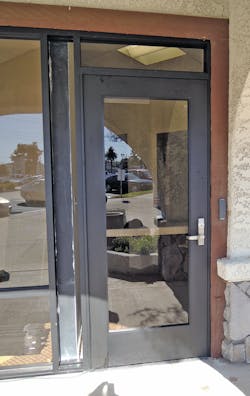Electronic access control has grown dramatically over the last decade. New products and mechanisms make installation easier and new technologies improve levels of security and control.
Many of us seem to forget how new the technology really is and how few systems have been installed. According to a number of resources, less than 10 percent of commercial buildings have electronic access control. A significant number of those commercial buildings have fewer than 10 doors. This provides a phenomenal opportunity.
Wired and wireless are the two basic choices for electronic access control systems. Installing both types of access control mechanisms require understanding of how the systems and components operate, and what equipment is used to build the chosen system.
Wired
Since most locksmiths have installed electric strikes, electrified locks and/or magnetic locks as part of single-door remote release or access control systems, we will begin by discussing wired access control systems.
Remote Release. The basic remote release single-door access control system incorporates an electronic locking mechanism such as an electric strike, lock or magnet. The locking mechanism is wired to a power supply that provides the proper voltage and sufficient amperage to power the lock. A momentary switch is installed, typically at a desk or counter having visual access to the opening.
Pressing the button either powers the locking mechanism or removes power from the locking mechanism, permitting the door to be opened. Access is controlled by a person who presses the button. When no one is near the button, remote access is not possible.
Standalone Readers. The next level of single-door access control replaces the person controlling access with credentials and a standalone access control reader. This unit contains the reader, software and the controller platform. These programmable readers determine the number of users, type of credential and functionality. The reader is usually card and/or keypad. Programming is normally accomplished at the reader. An administrator or locksmith can set up and maintain the access control system.
The standalone access control reader is located on the exterior of the swing side of the door. This reader is wired to the locking mechanism and the power supply. Each component of this access control system is electronic and requires power. The power requirements determine the type and size of the power supply.
Unlike the momentary button, the standalone access control reader grants access based on the credential presented. If the credential is valid, access is granted; the lock is unlocked for a predetermined time. If the credential is not valid, access is refused; the lock remains locked.
Multiple Doors. The next level of wired access control is for two or more doors, each having their own access control reader and locking mechanism. A power supply can be shared betweeb doors as long as there is sufficient amperage to power all doors at the same time.
At this level, multiport controller platforms are capable of controlling access, managing alarms and interfacing with an array of reader devices. Many multiport controller platforms are scalable to incorporate up to 64 doors using dual sub controller card reader interface panels for additional openings. Single sub controller card reader interface panels are available for odd numbers of doors.
These panels are available from access management companies, software providers, card access control systems manufacturers and locksmith distributors to control access. The panels must be configured to the software to operate with the users, the locks and the reader devices. Functionality of the locks is determined by these companies.
Once the panels have been configured, they are installed along with the chosen access control hardware. After they have been wired, the access control software is set -up and programmed to the doors, readers and locks. Then the users are programmed as individuals or in groups. An administrator or locksmith can manage the access control system.
Wired access control systems require wiring run from the power source to the lock mechanisms, alarm relays and readers. Depending upon the locations, running wiring can be easy or difficult. In addition, the choice of lock mechanisms can determine if the job is wired or wireless.
Wireless
Installing wireless access control systems is different. Wireless systems have standalone networked locks including cylindrical, mortise, narrow stile and trim for exit devices. These battery-operated networked locks communicate wirelessly via the Ethernet or 802.11B/G to any non-dedicated Windows-based PC.
For the locks to communicate with the PC, gateway or access points are required to transceive the communications. The gateways and access points have range limitations and only a limited number of networked locks can operate using one gateway or access point.
Note: Some lock manufacturers use a variation of wireless wired in order to communicate.
At this point in time, there is no easy way to provide standalone wireless access control using an electric strike, lock or magnet as power requirements for these locking mechanism cannot be satisfied by batteries.
Each locksmith should make the wired and/or wireless choices depending upon each individual installation.
For the remainder of this article, we will discuss aspects of an actual wired installation.
Wired Installation
Our example installation was part of a retrofit that included replacing the windows and doors to wide stile glass aluminum at an office complex. They upgraded the entrances and added electronic access control to an interior door equipped with a cylindrical lock.
For the exterior, HES 9600 electric strikes, electrified leversets, HID iCLASS 13.56MHz contactless readers, Sargent rim exit devices and door closers were installed.
The HES 9600 series Genesis™ electric strike operates with rim exit devices having up to a 3/4" throwPullmanlatch. The surface-mounted 9600 Series requires no cutting of the frame. Its stainless steel body resists tampering and vandalism, while extending the operational life of a surface-mounted electric strike. Voltage and operation is field selectable.
HID iCLASS 13.56MHz contactless open architecture readers are compatible with many proximity and smart card technologies. For this installation, two styles of readers were installed. The R15 mullion mount reader has a read range of up to 3.5” and the R40 wall switch mount reader has a read range up to 4.25”. Current requirements are 55mA at 5-16 VDC. HID recommends the use of a linear power supply.
For the interior doors, the cylindrical locks were electrically upgraded, an HID iCLASS reader was installed and raceways were drilled.
Wiring was run from each exit device, lock and reader to an industrial control panel enclosure containing the panels, power supply and backup battery. A dedicated Mercury EP1502 Access Platform and an MR50 Single Sub Controller Card Reader Interface Panels provide electronic access control for the openings. An Altronix LPS3R power supply and Revere RT-1640SL/M Plug-in Transformer provides power for the readers and the access platforms. This linear power supply and charger converts low voltage AC input to a low voltage 12VDC/24VDC output. A backup battery was installed.
A Command Access PS2 Class 2 Power Supply provided power for the electric strikes and locks. Two 12V, 4.0Ah sealed rechargeable lead-acid backup batteries were installed.
In a future issue, we will continue the discussion of wired and wireless access control systems.
For more information, contact your local locksmith distributor or the following manufacturers.
Altronix: www.altronix.com
HES: www.hesinnovations.com
HID: www.hidglobal.com
Sargent Lock: www.sargentlock.com
Securitron: www.securitron.com





